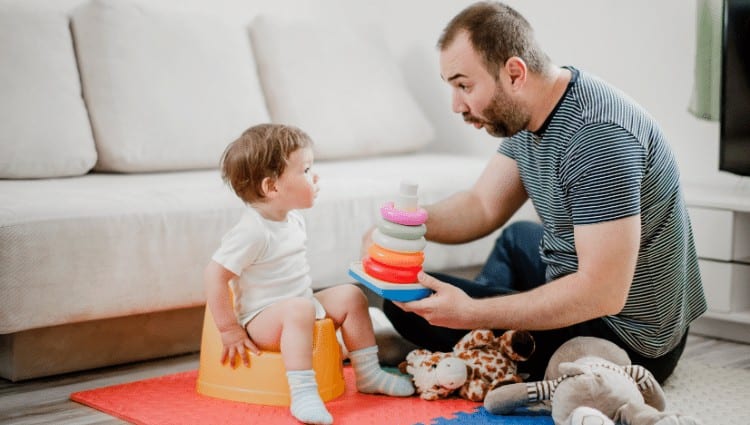
Congratulations! If you are reading this article it means you know you and your little big boy are ready to start a new chapter together. This is definitely a big step for both of you.
It’s a myth that ‘it’s easier to potty train girls.’ That is not always true. Every child is different, has their own strengths, and accordingly excels in different tasks.
This article throws light on ‘How to potty train boys?’ and gives detailed steps on – Potty Training Boys. This article will surely give you many insights based on my experience of potty training 3 boys (Yes—My Three musketeers, Triplets). I knew I had to train atleast one and other two will follow. This is typical when it comes to triplets or twins. They imitate and copy each other.
With these key tips, tricks, and hacks, you can say goodbye to those diapers forever and start shopping for some big boy underpants. No more diapers. Wow!! Doesn’t it sound great?
Potty Training Boys - Table of Contents
What is toilet/potty training?
Toilet/potty training is helping your kid recognize the urge to pee and poop by their body indications and then correctly using a potty training chair or toilet at the appropriate times. Simply put, making your kids understand whether they want to pee or poop.
Related Posts:
- 10 Ridiculously Easy Potty Training Methods to Choose & Explore for Your Child
- Reasons to stop breastfeeding—Physiological, Psychological, Medical, and Social
- How to stop breastfeeding? 10 Vital tips to help you with it and Faq’s
- Baby Teeth Chart: Sequence of eruption and Tips towards healthy baby dental care.
Identify when you should start potty training Or Signs that suggest you should start potty training your child
The first key step to this process is identifying if your child is ready for potty training. If your boy is not ready, then an early introduction can lead to a very frustrating and harrowing experience for both of you.
You need to be patient with your boy till you see the signs of readiness and slowly introduce potty training when he is ready.
As per experts, the age range where kids tend to be ready to potty train is quite wide—about 18 months to 3 years. I have even seen kids who are still not willing to be potty trained till about 8–9 years of age. However, these are very extreme and rare scenarios.
Generally, all kids do get potty trained between 2—4 years of age.
To start with—look for these signs to determine if your boy is ready for potty training:
- Your boy can walk towards and sit on the toilet seat—of course, on the baby toilet seat
- Your boy can pull his pants off and put them back on again
- Your boy can stay dry for an extended timeframe—like 2 hours or more
- Your boy understands and is able to follow basic instructions
- Your boy starts communicating with you when he needs to go to the potty
- Your boy starts showing interest in using the potty and/or in wearing the big boy underwear/underpants
Boys generally learn to potty train before girls do. As per my experience my boys (triplets) left wearing diapers before they were 2 years old and started communicating with us to take them to the washroom, whereas my elder daughter left wearing diapers completely between 2–3 years.
According to the American Family Physician (AFP), the average age of kids when they start showing readiness to be potty trained and starts sleeping though the night without pooping is even before 18 months, but can go up to 22–27 months.
Generally, boys tend to become completely potty trained between 25–32 months, and girls tend to be potty trained between 29.5–36 months.
These are, of course, averages and don’t reflect the development of any one child.
How soon will my boy be fully potty trained?
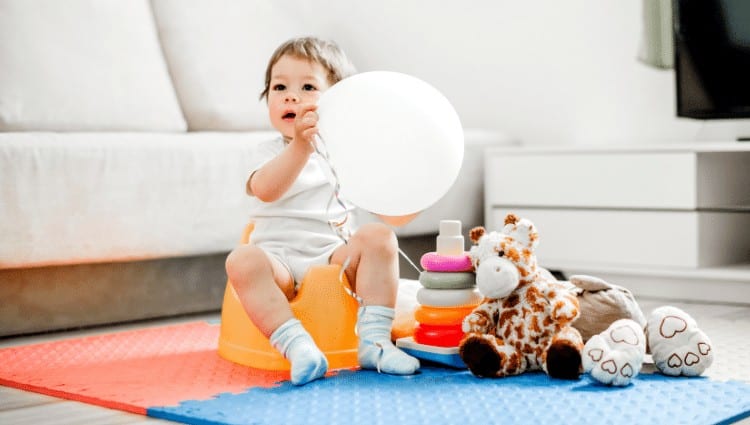
As discussed above, how long it takes for your boy to be potty trained completely depends on his readiness and personality.
Your pediatrician can bring this up when your child is between 18–24 months or you can discuss the same with your pediatrician around the same time for their guidance.
As per experts, most children are able to comfortably control their bladder and bowel movements between 3—4 years. Hence, it will be a good thing to start training your kids much before this period so that the process becomes easier and can be completed during the timeframe. You never know, sometimes it may click instantly and you can say good bye to those pesky diapers much earlier. A big cheers for your wallet as well!!!
A study has also showed that there is a direct correlation between when kids start potty training and when the child gets completely potty trained. Findings showcase that:
- Parents who start potty training their kids before they turned 2 years old, saw a 68% success rate of their child being properly potty trained by the time they are 3 years old.
- Parents who start potty training their kids after they turn 2 years old, saw a 54% success rate of their child being properly potty trained by the time they are 3 years old.
Other studies show that the sooner parents start the potty training process, the more successful they are in completing the process early. But there are always exceptions to the rules.
So, here are 15 easy steps on potty training boys—hopefully these steps can prevent any problems and frustrations that may come along with potty training boys.
Potty training boys—15 simple steps
Step 1: Deciding on a method
The first step is to understand the approaches used to initiate potty training.
There are many different types of potty training methods like infant potty training, child-oriented potty training, 3-day potty training, adult-led potty training, etc.
You need to evaluate which approach most suits you as well as your child. A few approaches are elaborated further for your convenience:
Child-oriented potty training
This concept follows ‘child’s readiness signs’ for each step of the toilet training process and is supported by the American Academy of Pediatrics (AAP). Further a research done in 2003 also suggests that this method is amongst the most successful methods of potty training.
In this method parents allow their child to take the initiative for trips to the bathroom, and frequently continue using diapers or pull-up training pants with this method until the child starts going to the bathroom before doing so in the diaper.
3-day potty training
In today’s day and age, parents do not have time to follow up on potty training of their child for a whole year or even more.
This method is a fast forward way of potty training the child. On day 1, all the child’s diapers are thrown out. Children are then made to wear just a T-shirt and big boy underwear. For this time do stock up on extra pairs of underwear as this process involves putting kids on liquid diet so as to encourage peeing.
Parents educate their children about the toilet and instruct them to let them know when they need to go to the bathroom, so that they can keep their new underwear dry.
As the process progresses it requires parents to stay calm, praise heavily, and use accidents (there are going to be loads, so be prepared for worst. With great speed, comes a price) as a chance to teach their child when they need to go to the bathroom.
Parent-led potty training
If you are Monica Gellar (from Friends) am sure this is your kind of potty training. This method needs parents to adhere to and adopt schedules and organize accordingly. This method is easier to follow when there are multiple caregivers.
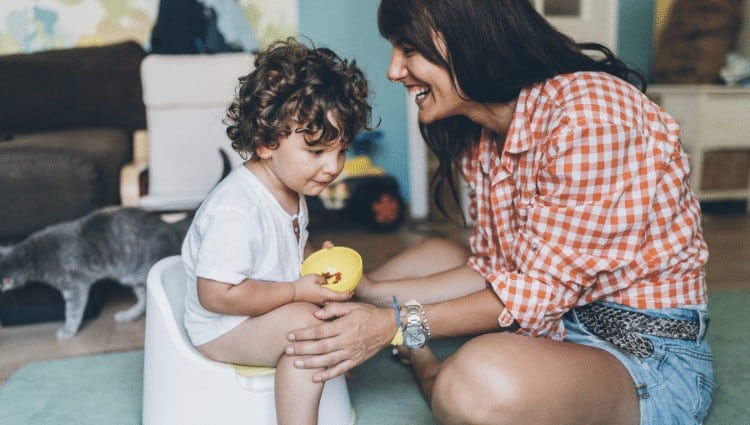
There are many variations on parent-led potty-training based on the schedule you create, as per you and your child’s convenience. But these methods share the idea that parents (or caregivers) initiate a child using the toilet on a set schedule or based on certain time intervals say may be every 2–3 hours or alternatively parents could encourage using the toilet after meals, in between activities, and even before sleeping.
Infant potty training
This method is sometimes referred to as natural infant hygiene. This method is popular among Asian and African families. This method starts when your child is a month old and is completed when the baby starts to walk.
The amount of time and dedication required in this method is quite substantial; hence, it’s not possible for all families. It also needs a set of constant caregivers and will not work if the caregivers change frequently.
Plus side is you SAVE BIG on diapers and your baby’s tushy is saved from getting those pesky diaper rashes.
In this method, you may need to start by avoiding diapers completely from the beginning. Parents could use a diaper for night for some time.
Parent have to work based on their baby’s indications and understand when their child is about to poop or pee. These signals can be time, pattern (with respect to eating or sleeping), words (sounds/ grunts even), or just pure intuition.
However, the parent or the caregiver has to be vigilant to notice these signs and then rush them to the bathroom.
TIPS to select the right Potty training method
- Understand the amount of time you have to devote to potty training your child
- As mentioned earlier that this is one of the most important factors, the readiness of your child
- And finally, how easily the method blends into your everyday life
While choosing the right method, decide ahead of time what words you’ll be using to address ‘Potty’ and ‘Pee.’ Keep in mind that others have to be comfortable and familiar with the words as well. Ensure everyone uses the same terminologies, especially if you decide the words will be in your native language.
Refrain from using negative connotations like ‘Stinky Poo,’ ‘Dirty,’ or ‘Yucks’ etc. while addressing your child’s bowel movements in front of him.
Step 2: Be ready with supplies
Potty training boys will need a few supplies like potty chair (ensure you buy one with a splash guard to keep the urine streams from painting your toilet walls), disinfectant tissues, a small colorful potty chart (you can either buy, print, or even make one—they are really good motivators), potty seats that nest onto your toilet seats (you get a wide range of amazing prints with plastic coated cushions, seats with stairs, with music etc. in the market), etc.
For potty training boys, you can also choose to have some of these supplies:
- Let him wear loose and comfortable clothing, especially the bottoms. This will help you in getting the clothing on and off easily.
- A training underwear will help absorb those accidents while you are potty training your child.
- Animal shaped urinal (with a spinning target—to keep him fascinated and engaged)
- Tot on the Pot Boy Doll, Book, and Potty Kit
- Some engagement games during pee and poop time.
- You could also have a potty-training book with pictures of kids using the potty, being happy, and getting claps from parents. Some classic books, like Once Upon a Potty or Everyone Poops.
- Hand soap that look like cartoon characters to help make washing fun.
Step 3: Set a date to begin
Cheers!!! You are all set to GO.
You have everything you need, just decide on a specific day and dive right in and help your baby boy get potty trained.
Mark it on a calendar and try to make it fun for your boy while he take his first steps into being potty trained. You could also lead up to the day by reading books, showing small cartoons on the topic, and even find something on potty training from his favorite characters.
Prepare your boy for what’s coming, talk to him, and discuss with him often on the process so that he is not taken by surprise.
When you start the potty training process, try and start it on a weekend. Needless to say, its better on a weekend as you and your partner can plan things better. On a weekend you both can be relaxed and have ample of time. You can also choose any other day that is appropriate for you and your partner as long as you both have time to spare.
You may find summers to be an ideal time to start potty training, as kids can go without clothing or pants, and babies also tend to pee lesser during the summer.
Step 4: Work on standing
Your boy may be peeing while he is sitting down on the potty seat, but you will have to eventually start training your boy to stand, aim, and pee—SAP.
You could have a small urinal with a moving target for practice. This is an interesting and fun way for kids to learn aiming.
It can be difficult for kids to get a hang of it, but eventually they will. Sometimes, uncircumcised boys may have a hard time directing urine flow, but this will become easier after a while.
The following tips will help you in teaching your child how to pee standing up:
- Keep the distance between him and the toilet/urinal smaller to make it easier for him to aim at close range.
- Make him hold the ‘far end’ of his penis while he aims his pee into the toilet/urinal.
- Create a game of it if possible and practice with the potty seat or urinal outside if a mess indoors is freaking you out.
- At the end—practice, practice, and more practice. Really, the only way he will get it is by doing it over and over again.
Step 5: Diapers OUT!
After a few weeks of your little one successfully going to potty, you can try and switch to underwear. You can start by switching to underwear for a few hours initially and then proceed slowly and steadily by increasing the number of hours your child spends in underwear till he is can stay throughout the day in it. This gradual transition to underwear will help in keeping your child comfortable and will cause less crankiness and
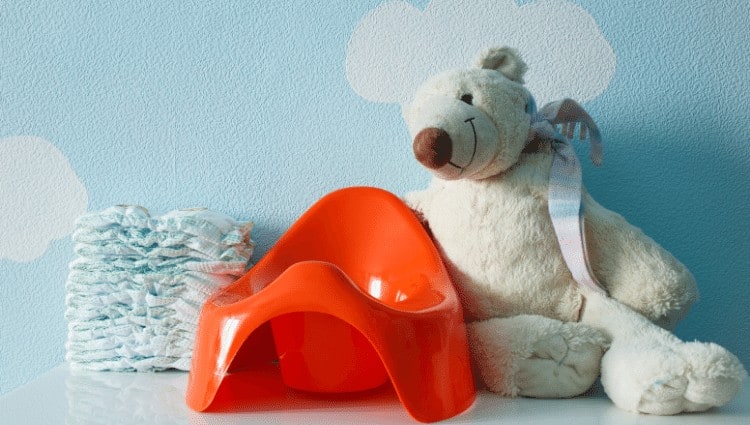
Involve your boy in this whole process. Pick up colorful underpants (The BIG BOY PANTS) of his favorite characters to attract and encourage him while making him feel like a BIG BOY.
You may find it helpful to stock up on a good number of new pairs of underwear during the initial period, otherwise you may have to do laundry a lot more frequently.
Do keep a few diapers handy till your baby is night potty trained and also for emergencies (pooplosions are unpredictable).
I used to buy diapers for my boys even after they were completely potty trained, as it was a convenient alternative while travelling.
Step 6: How to make your boy comfortable with underwear OR Practice with underwear
When your baby starts wearing underwear while undergoing potty training, it may sometimes be uncomfortable for him, as he is also trying to understand the entire situation. The pulling up and pulling down sometimes gets cumbersome and can result in him peeing and wetting his underpants.
Make him practice pulling his underwear up and down randomly during the day, so that he becomes comfortable with the process.
Motivate him to wear his big boy pants like his big brother (if any) or someone he looks up to. His favorite cartoon character pants can help as well.
Step 7: Stick to a routine
Stick to a routine if possible. You can take the baby to use the toilet every 2–3 hours, after every meal, or any other schedule that suits your baby’s needs. You will slowly determine your baby’s schedule and structure a routine around it. After that all you will need to do is follow the steps promptly.
Over a period, your boy will start communicating with you that he wants to pee or poop.
Step 8: Maintain consistency
Don’t get discouraged if your boy does not accept or follow the path charted by you for his potty training.
The key here is to have patience and maintain consistency. Keep on having conversations with your boy about going to toilet and continue using the potty seats, special hand wash, big boy pants, etc. to keep your child motivated to use the potty seat.
There could be days when your child is having mood swings and does not wish to use the potty seat. Don’t fret over it or get angry and push him to use the seat. This will discourage him from using the potty seat. Let a day or two go by, but don’t give up entirely. Keep being consistent and try to get your child back on track. Do not give up.
Step 9: Use rewards & praise your child
Rewards!!! WOOO….!!
Reward your boy with something every time he uses the potty seat. This will keep him motivated to continue to use the potty seat.
You could do the following to keep your kids motivated to use the potty seat:
- Give them small treats so that you can give 2 every time your baby uses the potty seat. I used to give M&Ms, jelly beans, jelly bears, etc. as small treats. But remember its effects on teeth, so don’t overdo it with candy. You could also give a combined reward like a big cookie or a muffin for the entire day. The key is to reward them with something they like.
- Give them Stickers/ Toys: You could shop for their favorite character stickers/small toys in bulk and give them as rewards.
- You could also give them Extra Playtime if that’s what motivates them.
- If they like a particular program once in while you could give them some extra screen time.
- You could tell them an extra bedtime story
- You could also create potty charts, give stars, etc. to keep the activity going while potty training is in progress. You can turn it into a game as well like if they collect 5 stars they get a car, 15 stars they get a robot, 20 stars a colorful book, etc.
- You can also look at innovating a bit and give a penny every time your boy pees/poops in a potty seat. Have a piggy bank. It may work on some kids.
- You can use all of the above options in combination as well or even invent your own motivators
You could increase your rewards as your boy progresses in potty training like when they start wiping/washing after themselves.
These small rewards motivate the kids a lot.
Further do remember praising too goes a long way. They feel very proud when everyone praises, claps, and so on. It makes him feel like a superhero. Keep praising as it encourages the boy to do better and better on a daily basis.
Step 10: Choose a comfortable location
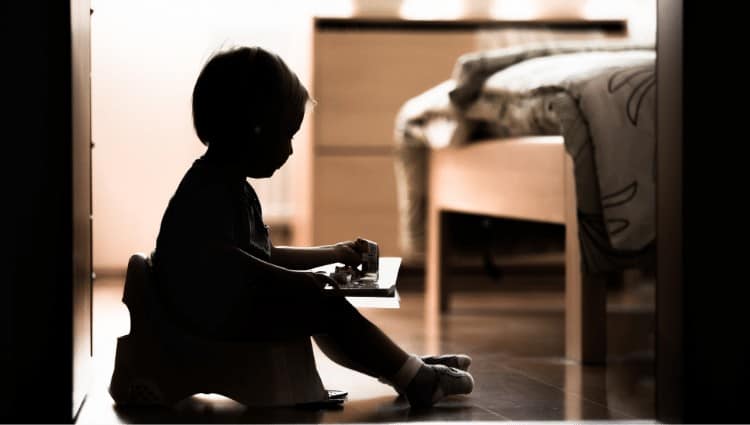
During the initial days, it may happen that the baby does not feel comfortable going into the toilet. In such cases, you can try to place small toilet seats near the toilet door on the outside, then slowly moving it inside, and then eventually placing on the potty seat.
You can also set up charts, toys, etc. to attract your baby to come inside the toilet.
Step 11: Ready, Steady, AIM
You should definitely try getting the moving target small urinals for your baby to practice his aim while peeing.
These urinals come in many attractive colors and a few come with characters as well, making them an interesting way to learn how to pee straight.
Step 12: Make potty training interesting and engaging
As mentioned earlier, try and make potty training in the toilet interesting for your boy with charts, books, toys, rewards, etc. so that your boy enjoys his time in the toilet and you have a happy baby taking steps towards a diaper-free life.
Step 13: Figure out your boys fears
You may notice that your baby sometimes does not want to use the toilet no matter what you do.
The reason for such behavior can be the baby’s fear. Baby may not feel uncomfortable with narrow spaces, he may have the fear of falling inside the potty seat, or even the noise of the flush may be scaring him.

No matter what the fear is, it is very essential that you understand what’s bothering your boy. Sometimes it can just be that he is feeling shy to do his business in front of you.
All that you need to do is to understand the fear and discuss the same with your boy.
These things can easily be handled by discussing them with your child. A change will not be seen immediately, and you may even need to seek help from a pediatrician or a counsellor in certain cases.
Step 14: Try it outdoors
When your child has started using the potty at home, try taking some small outings. This is a giant leap that you both will be proud of! Keep a change of clothing with you… just in case. You also need to ensure that he uses the toilet immediately before leaving your home and also after immediately reaching the destination.
Investing in a portable urinal or a travel potty seat is also a good idea if you plan to travel frequently.
Taking your kid outdoors can feel a little intimidating the first couple of times and accidents may occur. Travelling anywhere with a potty training baby is going to be difficult, but if you have to travel someplace that is particularly inconvenient (like a wedding, perhaps) you can use a pant-style diaper again to avoid any messy situations.
Step 15: Introducing Night potty training
Every kid goes through potty training in two phases—Daytime and Nighttime. Usually, kids get daytime potty trained first and continue to use diapers at nighttime and even at naptime.
Most kids are able to remain dry or use the bathroom at night by the time they are 5–7 years old.
Things you can do to help:
- Avoid or reduce the amount of liquid intake in the hours before bedtime.
- Encourage your boy to use the toilet before he goes to bed.
- Cover your child’s mattress with a guard to protect it from accidents and leakages.
- Remember that that nighttime training is a different ballgame altogether and that your child will eventually get used to the process.
Few do’s & don’ts while potty training your boy
The above steps for potty training will clear any doubts and problems that you may face while potty training your boy. Here are some do’s and don’ts to summarize what we have discussed so far.
Potty training Boys—Do’s
- Be patient
Look for any signs like physical, behavioral, or cognitive signs, before you start potty training
Take some insights of your boy’s behavior and other signs from his preschool teachers and day-care providers before you draw a comprehensive plan for his potty training
Make the potty-training fun and motivational by trying some innovative methods and games. Using books and CDs about potty training will also help him understand his situation better. Don’t forget to reward him on his achievements.
Potty training Boys—Don’ts
- Don’t push him or insist that he only uses the potty seat to do his business. This may discourage him and he may start avoiding the potty seat altogether
- Do not try to achieve all levels at one go
- Never chide him or make comparisons with other children his age. The goal is to encourage and not discourage
- If you show obvious signs of frustration or irritation, he may even stop trying
Key takeaway
Parenting has never been a cakewalk, and this potty training phase is definitely a patience-testing time. But I hope this article will help you harness your inner Master Shifu and help your Baby Po achieve the greatness of being diaper free.
Honestly, there is no right or wrong way of potty training. I have given 15 steps and a few tips in this article—‘Potty Training Boys Made Easy. Step by Step Guide, Do’s & Don’ts, and more…’—to ease your first steps into potty training boys.
How you do it, should completely depend on your family, you, and your baby’s needs. What I have given you are the basic guidelines that you can follow while you potty train your boy.
And there is definitely no hard and fast rule that you need to continue with a single approach. You should be open to change, adapt yourself, and improvise and that will help a lot while potty training boys.
Hope my article on ‘Potty Training Boys Made Easy. Step by Step Guide, Do’s & Don’ts, and more…’ helps you and your child progress to a diaper free life.
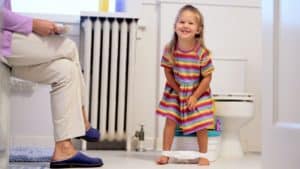




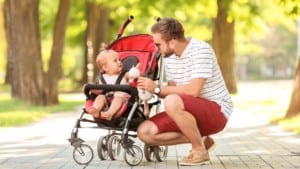




There is obviously a lot to realize about this. I think you made various nice points in features also. Rgds, Elly
Hi, Neat post.
Thanks for the tips.
Rgds, Betty
Nice guide. Thanks for sharing your experience. I will try these tips.
Hope it works on my 3 year old.
Thanks Caroline.
I am sure it will work. Just have patience. All the best 🙂
Superb tips. I really enjoy reading through on this blog, it holds fantastic content.
Keep up the good work.
Nice one. I guess you have gained experience from raising your triplets.
Fantastic beat! I wish to apprentice while you amend your website, how could I subscribe for a blog web site?
Super post!
cheers.
I’m really enjoying the design and layout of your site. It’s a very easy on the eyes which makes it much more enjoyable for me to come here and visit more often. Did you hire out a designer to create your theme? Excellent work!
Thanks Neil you liked our blog.
thank you for posting the tips on potty training boys. I am pleased to find this website through google.
Thank you Rylee
Thanks. We were really looking for some tips on potty training boys. You have provided good tips and insights.
Thanks Kristina.